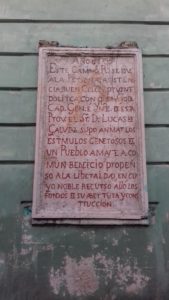SEE RULO’S COLORFUL AND DELIGHTFUL ILLUSTRATION OF THE ARCH OF SAN JUAN IN THE MAY 1 PRINT EDITION OF MID-POINT!….
Merida’s San Juan neighborhood is located roughly between Calles 58 and 62 (east to west) and Calles 61 and 69 (north to south) in the historic colonial center of the city. One of the anchors of the neighborhood is a prominent colonial arco (arch) that spans Calle 64 just southwest of the plaza that contains the Church of San Juan.
Merida’s nickname is Ciudad Blanca. Some early observers thought this nickname might have derived from the whitewash obtained from local limestone deposits and used to paint walls and facades from the colonial period until the beginning of the 20th century. Others have posited the nickname was due to Merida’s cleanliness.

But the consensus of most historians is that Ciudad Blanca came to be Merida’s common alias due to the motivation of its founders to create a White city, that is for people of the White race. The Spanish conquerors led by the Montejo family and later European colonizers wanted to preserve within the walled confines of the city a bastion for its White setters.
Beyond the four access gates or “arcos” would lie the Indian neighborhoods. The arcos were intended to provide some security for the White settlers fearful of the stubborn Mayan resistance that persisted throughout the subsequent centuries and broke out into open revolt in the rebellion led by Jacinto Canek in the mid-18th century and the protracted caste war that dragged on throughout the second half of the 19th century.
However, the sprawling growth of Merida – both in population and geographic terms – overwhelmed the purpose of the arcos to delimit the White City, and they have come to be an anachronistic but charming relic of the city’s colonial past.
By Robert Adams with information from WikiPedia and other sources.
PHOTOS: Rulo
.





